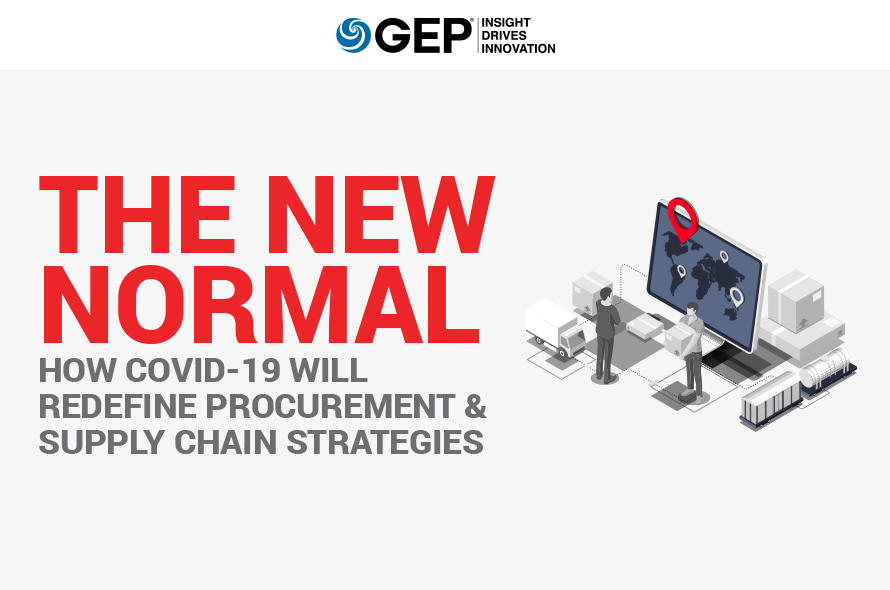COVID-19 has upended global procurement and supply chains, exposing critical gaps and vulnerabilities.
It’s time to change the rule books. It’s time to organize for the new "normal."
In a new analysis piece — The New Normal: How COVID-19 Will Redefine Procurement & Supply Chain Strategies — GEP’s experts discuss how the pandemic would bring about a paradigm shift in enterprise priorities. They also share specific steps you can take now to prepare for this strategic transition.
What’s Inside:
- Why businesses would now be willing to pay a premium for supply continuity
- How supplier diversification will increasingly be a top priority
- Why supply risk from now on would be as critical as, if not more than, financial risk
Read today to understand the new enterprise priorities and align your procurement and supply chain strategies for the post-pandemic world.
China, the global supply chain hub, may have relaxed coronavirus-related restrictions and started reopening its factories, but the lockdown it imposed for close to two months to contain the outbreak will continue to have a massive impact on supply chains the world over. The shutdown many countries have enforced as the infection continues to spread — and the looming threat of job losses and recession — has led to further disruptions, affecting both demand and supply across industries. Complete recovery is a distance away, but this is the time for businesses to take a close look at their supply chains, and the vulnerabilities exposed by the pandemic.
1. THE MAIN DISRUPTION IS YET TO COME
The global supply chain is set to change drastically, and companies must implement a solid plan to minimize disruption in the future — more is yet to come. As a result of the COVID-19 pandemic and the resultant lockdowns, we are seeing queues for toilet paper, and shortages of PPE and critical hospital equipment. The pandemic has impacted various industries such as food, restaurants, airlines, travel, hospitality and small businesses. However, disruptions in the food and consumer products supply chains are likely to be relatively brief and minor in scale, as manufacturing tends to be local to consumers with shorter lead times and simpler supply chains.
The greater disruption will be seen in complex, multi-step supply chains that rely on sub-components from other geographies. Disruptions for manufacturers relying on China-based components are just beginning to be felt as the safety stock for components is nearly exhausted — the impact will become more visible soon. Peak disruption for multi-step, multi-geography supply chains is likely in three to six months from now.
ACTION: Supply chain team members must evaluate their company’s exposure, communicate to executives at all levels, and enact contingency plans even if they are not feeling the impact yet.
2. RELIABLE SUPPLY IS THE NEW PRICE
Both buyers and sellers need to ramp up significant and focused effort once the pandemic recedes as there will be a “new normal” in commercial discussions. Sourcing decisions will increasingly be made based on which suppliers have the most redundancy in their supply chains. Businesses will be willing to pay a premium for resilience in their supply chains, and price will be secondary for many critical supply components. There will be wholesale re-evaluation of existing supply chain relationships worldwide.
ACTION: Prepare for how your organization will adapt both its sales and procurement practices to this new commercial reality.
3. ACCELERATION OF MORE DIVERSE (NON-CHINA) SUPPLY CHAINS
Companies large and small will now have to look deeper into their supply chains to better understand the impact of the crisis in real time. Expect to see more artificial intelligence and machine learning activities applied in the supply chain to reduce risks. For a long time, China’s manufacturing scale, historical cost advantages, and favorable government policies made it an easy choice for the one-stop supply chain. However, over the past few decades, we’ve seen a slight trend toward diversification, that is, adding redundancy outside of China.
Over the past three years, this trend has further accelerated because of increasing concerns regarding intellectual property rights, tariff unpredictability, shortened product cycle times and natural disasters. The COVID-19 supply chain impact will rapidly accelerate this trend toward diversification. The “all eggs in one basket” approach to the supply chain will no longer be acceptable from a risk standpoint for leading global companies as the financial impact is huge in today’s dynamic market.
ACTION: Communicate with leadership to define “guide rails” for diversification. Develop near-, medium and long-term goals that your organization can begin to execute.
4. PLAN FOR DISRUPTION
Historically, supply chains have been designed for optimal efficiency under standard operating conditions. However, the number of disruptive events — hurricanes, refugee crises, tariff changes, to name a few — has increased dramatically over the past five years. Disruption is the new normal. The COVID-19 pandemic will be the tipping point. Businesses will begin to design their supply chains with a different set of priorities:
- Priority #1: Certainty of supply under adverse conditions
- Priority #2: Efficiency under standard operating conditions
ACTION: Evaluate your current processes and technologies to determine how well-suited they are to adapt to this new prioritization.
5. SUPPLY RISK IS THE NEW FINANCIAL RISK
After the 2008 financial crisis, businesses stepped up their focus on characterizing and monitoring financial risks within the organization and of their trading partners (customers and suppliers). There was explosive growth in new technology and service offerings to address this market need. “Supply risk” will be analogous to “financial risk” after the COVID-19 crisis. Once the immediate crisis subsides, boards and shareholders will demand that the organizations adopt a more proactive stance toward managing supply risk.
ACTION: Begin defining and testing your requirements with the leadership now in order to ensure that the new capabilities address core needs, versus just “checking the box” of mandated actions.
KEY QUESTIONS TO RAISE WITHIN YOUR ORGANIZATION
- How do our supply chain contracts stack up to meet the new normal?
- How resilient are our suppliers and their sub-suppliers in the supply chain ecosystem?
- Are our suppliers innovating to meet demand and reducing risks, even more after the pandemic?
- Is our supply chain running on an antiquated platform? What is the financial impact?
- How transparent is our supply chain ecosystem? Do we see warning signs of risk before the risk materializes?
- Do we have a supply chain crisis mitigation plan that can be executed quickly?
- How did the COVID-19 crisis impact the overall business? What can we learn from it and improve upon?

